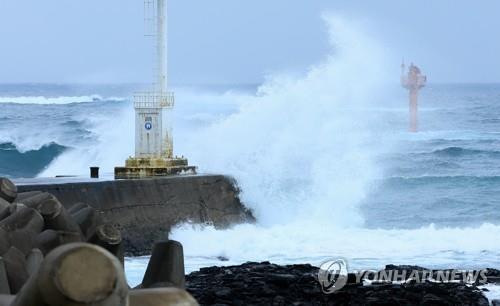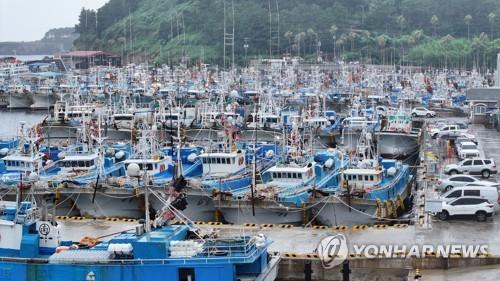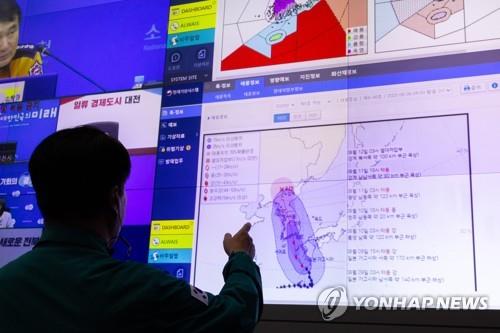- California Assembly OKs highest minimum wage in nation
- S. Korea unveils first graphic cigarette warnings
- US joins with South Korea, Japan in bid to deter North Korea
- LPGA golfer Chun In-gee finally back in action
- S. Korea won’t be top seed in final World Cup qualification round
- US men’s soccer misses 2nd straight Olympics
- US back on track in qualifying with 4-0 win over Guatemala
- High-intensity workout injuries spawn cottage industry
- CDC expands range of Zika mosquitoes into parts of Northeast
- Who knew? ‘The Walking Dead’ is helping families connect
S. Korea braces for powerful Typhoon Khanun
South Korea came under the influence of the powerful Typhoon Khanun on Wednesday, as the typhoon is on a path to make landfall on the country’s southern coast and pass vertically across the Korean Peninsula, the weather agency said.
Khanun was advancing northward over waters 240 kilometers southeast of Jeju Island’s Seogwipo at 8 p.m., with a central pressure of 956 hectopascals and maximum wind speeds of up to 37 meters per second, the Korea Meteorological Administration (KMA) said.
The typhoon is predicted to maintain its northward advance to reach waters 120 km south of the southern coastal city of Tongyeong at 3 a.m. Thursday and make landfall in the country later that morning, according to the agency.
When it reaches South Korea, the typhoon will remain “strong” in intensity, bringing winds faster than 15 meters per second in its 340 km radius and faster than 25 meters per second in a 120 km radius, the KMA said.
The city was forecast to experience heavy rainfall, ranging from 40 to 60 millimeters per hour, from Wednesday afternoon to Thursday morning.
As of 9 p.m., most regions across the country had been experiencing downpours of up to 5 to 15 millimeters, with strong winds of more than 20 meters per second, according to the KMA.

Khanun may then travel further north to brush by the central city of Cheongju at 3 p.m. Thursday and pass as close as 30 km east of Seoul at 9 p.m. the same day before crossing the inter-Korean border to reach 120 km southeast of the North Korean capital of Pyongyang at 3 a.m. Friday, the agency said.
By the time Khanun nears Cheongju, the typhoon’s force may diminish slightly to “medium” with the central pressure likely at 980 hPa and maximum wind speeds of 29 meters per second. A typhoon of that scale could blow away buildings’ roofs and make it difficult to drive vehicles at normal speeds.
If Khanun proceeds as forecast, it would mark the first typhoon to enter the country from its southern end and travel vertically across the Korean Peninsula, including North Korea since 1951, when relevant KMA information became available.
A KMA official said that Khanun’s expected path after its landfall in South Korea could change due to geographic reasons. “It is expected that the typhoon would not move in a straight line and may, for instance, circumvent a mountain.”
President Yoon Suk Yeol urged all-out efforts to minimize any casualties and damage by mobilizing available resources.
“We cannot ward off the forces of nature, but we can minimize the loss of lives with close cooperation among related agencies, in-advance evacuation and thorough controls,” Yoon was quoted as saying in a meeting with related officials.
The typhoon put Jeju Island and the southern coast under its influence Wednesday morning, bringing winds as fast as 24 meters per second.
More than 200 flights, including those going to and from Jeju Island, were grounded Wednesday while all passenger boat services from and to Jeju were also suspended, authorities said.
Jeju International Airport reported that out of the 492 flights scheduled for the day, over 160 had been canceled as of 6 p.m.
Starting at 10 p.m., typhoon advisories will be upgraded into warnings for the entire land area of the island and its offshore waters, according to the Jeju Regional Meteorological Administration.
The government advised public institutions and companies to adjust commuting hours Thursday as the typhoon is likely to make landfall during the morning rush hour.

Beginning Wednesday, Khanun is expected to put the entire nation under its influence until Friday morning, dumping heavy rain and causing strong wind. Gangwon Province, in particular, may experience rain as strong as 100 millimeters per hour
Gangwon is forecast to receive accumulated precipitation of up to 600 mm while the greater Seoul area is expected to see up to 200 mm of rain. The rest of the country will also experience between 30 mm and 300 mm of rain.
Southern coastal regions will also see wind as strong as 40 meters per second, the agency said.












